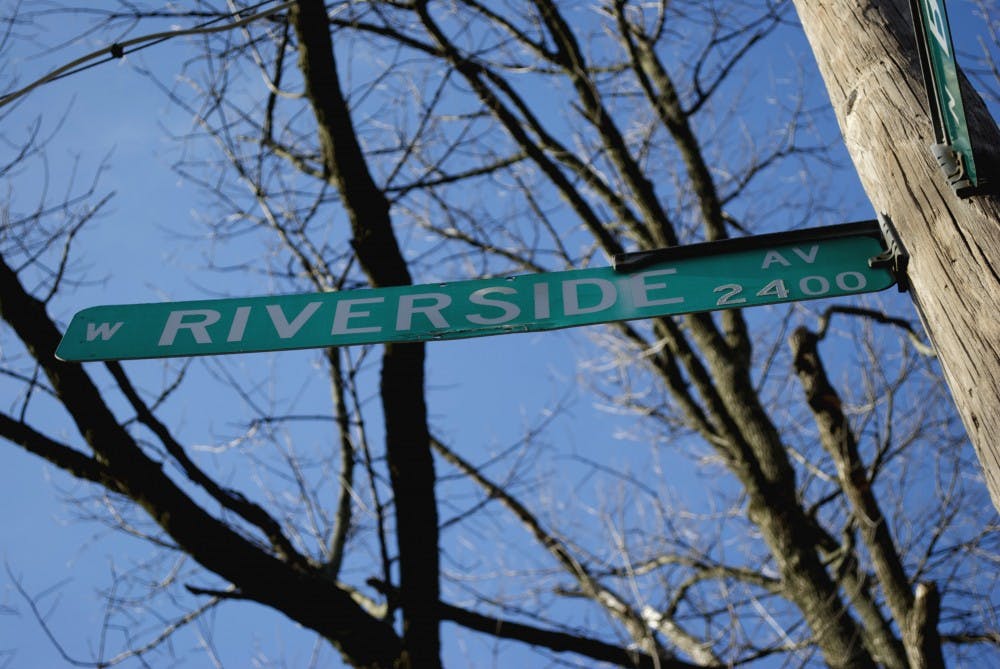Nine Steps to Measuring Greenhouse Gas Emissions:
1. Real-time communication, monitoring and reporting
2. Energy management through the geothermal district heating and cooling network
3. Energy conservation within information technology
4. Transportation efficiency
5. Building efficiency
6. Energy conservation policy
7. On-site solar photovoltaic (PV) production
8. Off-site wind energy electrical production
9. Off-site PV electrical energy production
Obtained from the Ball State University Climate Action Plan.
The university will tear up and redo Riverside Avenue this summer as they install new geothermal piping.
The construction will take place from May 3 to Aug. 7, and is segmented into four phases: from Emens drive to Martin Street, Martin Street to Dill Street, Dill Street to Dicks Street and Dicks Street to DeHority drive.
The installation of the pipes requires tearing up those sections of Riverside Avenue, which will be redone after the placing of the pipes is complete. Jim Lowe, Director of Engineering Construction and Operations, said the condition of the street will be “much improved,” and that the construction was planned during a time that would create the least amount of traffic and problems for the university.
“We designed the staging of the project in such a way that it would not have a detrimental effect on the students and their parents reaching DeHority Hall, especially when they come in through the east,” Lowe said. “[We] purposely worked with those who are responsible for conferences, orientation, anybody that brings outsiders to campus; we worked with them on scheduling.”
Lowe said he planned for the final leg of the construction from Dicks Street to DeHority drive to occur after summer orientation for new students was complete, due to new students typically being housed there.
The installation of the pipes is one of the final stages in Ball State's effort to switch to a geothermal heating system. Lowe said the university has been working on this project for five years, and it will be completed after the projected installation of the same types of pipes on University Avenue in summer of 2016.
Once the construction is complete, the university will have installed ten miles of piping across campus, and all 47 buildings on campus will be connected to the system.
The geothermal system uses hot and cold water to heat and cool buildings. The water is heated and cooled using geothermal energy, which is obtained through bore holes placed in the earth. The university currently has 1000 miles of piping inserted into these bore holes. The bore hole piping and the supply and return piping all lead back to two buildings that pump the water throughout campus. The supply and return pipes that are being installed underneath Riverside will be used to heat and cool Woodworth Complex, DeHority Hall and any future buildings that may be constructed in that area.
The project is being funded through state appropriations, which allotted $78 million for the project. The university also received a $5 million grant from the US Department of Energy in 2009, which together should cover the cost of construction.
The installation of the geothermal system is part of a plan by Ball State to achieve climate neutrality, called the President's Climate Commitment. This plan, which will requires universities to eventually have zero emissions, has been signed by 695 universities to date.
Ball State's pollution emission at the start of the plan was 150,000 metric tons per year, and is now down to about 110,000 metric tons per year. Robert Koester, director of Center for Energy Research Education and Service, said once all 47 buildings are online to the geothermal system there will be a significant decrease in emissions. The target date to have zero emissions is 2050, which Koester said is doable as well as generous.
“We’re thinking now in terms of finding ways to try to pull that forward so that we don’t wait so long, we’d like to make it happen quicker rather than later,” Koester said. “There’s a lot of good will on campus, a lot of interest on the part of upper administration to do all we can, so I think that there’s a chance that we can move that date forward.”
Lowe said switching from coal to the geothermal heating system greatly reduces the university's pollution output.
“By not burning coal we’re not producing the 85,000 tons of CO2 that it used to produce… we’re not emitting carbon monoxide, we’re not emitting particulate matter,” Lowe said. “What we are doing is making hot water through the geothermal process which is a lot more efficient … it’s going to be a nearly-50 percent reduction in our carbon footprint. It’s environmentally sound and friendly.”
|
Nine Steps to Measuring Greenhouse Gas Emissions: 1. Real-time communication, monitoring and reporting 2. Energy management through the geothermal district heating and cooling network 3. Energy conservation within information technology 4. Transportation efficiency 5. Building efficiency 6. Energy conservation policy 7. On-site solar photovoltaic (PV) production 8. Off-site wind energy electrical production 9. Off-site PV electrical energy production Obtained from the Ball State University Climate Action Plan. |





